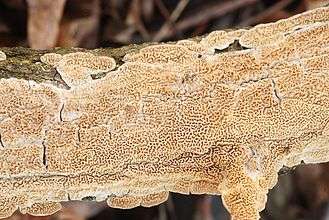Irpex
| Irpex | |
|---|---|
 | |
| Irpex lacteus | |
| Scientific classification | |
| Kingdom: | Fungi |
| Division: | Basidiomycota |
| Class: | Agaricomycetes |
| Order: | Polyporales |
| Family: | Meruliaceae |
| Genus: | Irpex Fr. (1825) |
| Type species | |
| Irpex lacteus (Fr.) Fr. (1828) | |
| Synonyms[1] | |
Irpex is a genus of resupinate fungi in the family Meruliaceae. Species produce fruit bodies that grow as a crust on the surface of dead hardwoods. The crust features an irpicioid spore-bearing surface (for which the genus is named), meaning it has irregular and flattened teeth. Irpex is distinguished from the similar genera Junghuhnia and Steccherinum by the simple septa found in the generative hyphae.[3]
Species
- Irpex africanus Van der Byl (1934)[4] – South Africa
- Irpex alboluteus Rick (1959)[5] – Brazil
- Irpex aridus (Svrcek) Kotir. & Saaren. (2002)
- Irpex castaneus Lloyd (1920)
- Irpex conchiformis (Sacc.) Kotir. & Saaren. (2002)
- Irpex consors Berk. (1878)
- Irpex cremicolor Miettinen, Niemelä & Ryvarden (2007)[6] – North Europe
- Irpex destruens Petch (1909)
- Irpex epitephrus Cleland (1936)[7]
- Irpex gracillimus Pilát (1925)
- Irpex hacksungii J.S.Lee & Y.W.Lim (2009)[8] – Korea
- Irpex holoporus (Pers.) Sacc. & Traverso (1910)
- Irpex hydnoides Y.W.Lim & H.S.Jung (2003)
- Irpex irpicinus (Berk. & Broome) D.A.Reid (1963) – Australia
- Irpex iyoensis Yasuda (1917)
- Irpex javensis Lloyd (1925)
- Irpex kusanoi Henn. & Shirai (1900)
- Irpex lacteus (Fr.) Fr. ( 1828)
- Irpex lamelliformis Lloyd (1917)[9]
- Irpex lepidocarpus (P.Karst.) Sacc. & Trotter (1912)
- Irpex litschaueri (Bourdot & Galzin) Kotir. & Saaren. (2002)
- Irpex longisporus Rick (1959)[5] – Brazil
- Irpex longus Rick (1959)[5] – Brazil
- Irpex merulioides (Berk. & Broome) Lloyd (1914)
- Irpex microdon Rick (1959)[5] – Brazil
- Irpex mikhnoi (P.Karst.) Sacc. & Trotter (1912)
- Irpex miyabei Lloyd (1923)
- Irpex mukhinii (Kotir. & Y.C.Dai) Kotir. & Saaren. (2002)
- Irpex murashkinskyi (Burt) Kotir. & Saaren. (2002)
- Irpex narymicus (Pilát) Saaren. & Kotir. (2002)
- Irpex noharae (Murrill) Sacc. & Trotter (1912)
- Irpex ochrosimilis Lloyd (1924)
- Irpex owensii Lloyd (1916)
- Irpex pallidus Lloyd (1920)
- Irpex palmatus (Berk.) Speg. (1959) – Rio de Janeiro
- Irpex poria Rick (1959)[5] – Brazil
- Irpex rickii Lloyd (1925)
- Irpex roseotingens (Hjortstam & Ryvarden) Saaren. & Kotir. (2002)
- Irpex sepiarius Lloyd (1917)
- Irpex subhypogaeus Rick (1932)
- Irpex subrawakensis (Murrill) Saaren. & Kotir. (2002)
- Irpex tasmanicus Syd. & P.Syd. (1903)
- Irpex tiliaceus Pilát (1925)
- Irpex tomentosocinctus Rick (1959) – Brazil[5]
- Irpex unicolor Lloyd (1920)
- Irpex vagus (Burds. & Nakasone) Saaren. & Kotir. (2002)
- Irpex vellereus Berk. & Broome (1873) – Philippines
- Irpex versatilis Lloyd (1917)
- Irpex woronowii Bres. (1920)
References
- ↑ "Synonymy: Irpex Fr.". Species Fungorum. CAB International. Retrieved 2014-09-19.
- ↑ Ryvarden L. (1973). "New genera in the Polyporaceae". Norwegian Journal of Botany. 20 (1): 1–5.
- ↑ Ryvarden, L.; Melo, I. (2014). Poroid Fungi of Europe. Synopsis Fungorum. 31. Oslo, Norway: Fungiflora. p. 237. ISBN 978-8290724462.
- ↑ van der Byl, P.A. (1934). "Die Suid-Afrikaanse Hydnaceae of Stekelswamme". Annale van die Universiteit van Stellenbosch. 12 (1): 1–9.
- 1 2 3 4 5 6 Rick, J.E. (1959). "Basidiomycetes Eubasidii in Rio Grande do Sul - Brasilia. 3. Hypochnaceae, Clavariaceae, Craterellaceae, Hydnaceae". Iheringia (in Spanish). 5: 125–192.
- ↑ Miettinen, O.; Niemelä, T.; Ryvarden, L. (2007). "A new polypore Irpex cremicolor described from North Europe". Mycotaxon. 102: 415–424.
- ↑ Cleland, J.B. (1936). "Australian Fungi: notes and descriptions. - No. 11". Transactions and Proceedings of the Royal Society of South Australia. 59: 219–220.
- ↑ Lee, J.S.; Kim, C.; Lim, Y.W. (2008). "Irpex hacksungii sp. nov. (Polyporaceae) from Korea". Mycotaxon. 106: 423–429.
- ↑ Lloyd, C.G. (1917). "Mycological Notes 50". Mycological Writings. 5 (50): 701–716.
External links
This article is issued from Wikipedia - version of the 9/10/2016. The text is available under the Creative Commons Attribution/Share Alike but additional terms may apply for the media files.